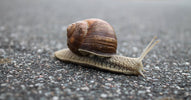
Effective tips to combat and prevent snails in the vegetable garden
, 5 min reading time

, 5 min reading time
#VALUE!

Every vegetable gardener knows the frustration of snails attacking your carefully cultivated plants. Sometimes it seems like they appear out of nowhere and wipe out all your hard work within a few hours. But don't worry, there are effective ways to combat these slimy invaders.
Snails can be both useful and problematic in the vegetable garden. Understanding their functions and the problems they cause helps achieve better balance.
Snails contribute to biological decomposition in the vegetable garden. They help break down dead plants and organic matter, which contributes to soil fertility. Their slime can improve the structure of the soil, which promotes water and air circulation.
In addition, snails serve as a food source for various animals such as birds and hedgehogs. These animals help maintain the natural balance in the garden, keeping pests under better control. By not completely removing snails from the garden, I support a diverse ecosystem.
Snails cause damage to crops by eating leaves and young shoots. They can quickly damage a large number of plants, leading to reduced yields and quality of production. Some snails carry diseases and parasites that can spread in the vegetable garden.
In addition, snails multiply quickly under humid conditions, which makes control difficult. It is therefore important to use effective prevention and control strategies to keep problems under control. This way I maintain a healthy vegetable garden with minimal damage from snails.
I often encounter different types of snails in my vegetable garden. To combat them effectively, it is important to identify the specific species.
I mainly see three types of snails in my vegetable garden:
Slugs: These snails, such as the large terrestrial snail (Arion ater), have no shell and vary in color from brown to black. They like to feed on soft crops such as lettuce and cabbage.
Snails: The common snail (Cornu aspersum) and the garden snail (Cepaea nemoralis) are the most common snails. They have a spiral-shaped house and eat both living plant material and fallen leaves.
Spanish road snail: This invasive species (Arion vulgaris) is larger and more aggressive. It feeds on various crops and can cause a lot of damage in a short time.
I recognize harmful snails by specific characteristics:
Eating marks: Holes and ragged edges on leaves indicate snail eating. Young plants are especially vulnerable.
Snail trails: Shiny, slimy trails on the ground and plants indicate the presence of snails.
Feeding time: Harmful snails are mainly active at night and in damp weather. They hide during the day under stones, wood and leaves.
By identifying these characteristics, I can take targeted measures to protect my crops and maintain balance in my vegetable garden.
In my experience, snail infestations can quickly get out of hand in the vegetable garden. Here I cover both natural and chemical methods to effectively control snail populations.
Natural enemies such as birds, hedgehogs and ground beetles play an important role in snail control. I encourage the attraction of these animals by installing nest boxes and maintaining a varied garden environment. Using copper tape around planters and raised beds also works well because snails don't like to crawl on copper. Another effective method is the use of nematodes, which infect and kill snail larvae. Examples of effective variants are Phasmarhabditis hermaphrodita.
Chemical pesticides such as slug pellets can provide quick results, but must be applied carefully to avoid harm to other animals and the environment. I prefer to use iron phosphate granules because they are less harmful to pets and wildlife than methaldehyde. It is essential to distribute the granules evenly across the garden and not concentrate them in one spot. Always follow the instructions on the packaging to ensure safe and effective use.
By applying these methods, I can efficiently control the snail population in my vegetable garden.
Taking preventive measures helps to prevent snail infestations in the vegetable garden. Here I inform about effective methods to discourage snails.
Make sure the garden structure does not invite snails:
Raised beds: Plant in raised beds to make it harder for snails to access them.
Gravel paths: Use gravel paths around plants to create a barrier.
Water management: Avoid excess water to minimize damp, snail-friendly areas.
Copper bands: Place copper bands around plants to disorient snails.
Eggshells: Sprinkle crushed eggshells around crops for a sharp, unpleasant texture.
Coffee grounds: Spread coffee grounds on the ground to deter slugs with their caffeine content.
Tackling snails in my vegetable garden is an ongoing challenge that requires patience and creativity. By using a combination of natural and chemical methods I can effectively control the snail population without disrupting the ecosystem. Preventive measures such as raised beds and gravel paths help enormously.
I've found that using copper tape, eggshells and coffee grounds really works to deter snails. It's important to stay consistent and check my garden regularly. This way I can enjoy a healthy and productive vegetable garden.


